ELL students of GlenOak
How the ELL students of GlenOak High School are learning English and even more from the EL class
The C Hallway: A picture of Mrs. Perduk’s classroom in the upper C Hall, “I hope this helps students learn that there is a difference between ELA and ELL,” Perduk said.
You have spent your whole life in another country, English is not your first language and you have never known anything different. Then one day, everything changes. You find out you are moving to another country. That country being America.
For ELL students at GlenOak this is their reality. ELL students, or English Language Learners are first-generation students from other countries, for most of them English is not their first language. ELL teacher Kimberly Perduk is helping these students learn English step-by-step to make their lives in America just a little easier.
“One benefit of teaching students from other countries is that I am always learning,” Perduk said. “I am always learning about different cultures and languages and that makes this job incredibly fulfilling and it provides me with a global perspective.”
Perduk is finding out things about other cultures that she may have never known before. This is even including some new languages.
“It is a myth that teachers of speakers of other languages (TESOL) must also speak another language or the language of their students,” Perduk said.
There are actually many other techniques to communicate with and instruct ELL students in the English language.
“What we do is pay attention to the language of the student – the syntax and grammatical rules. What is similar and different from the English Language. In this way, we can focus on explicitly teaching the students what is the same and different from the English language,” Perduk said.
The students of ELL are in a very fast-paced environment learning English. What would usually need to be learned in 6-7 years, has to be summed down into a couple of high school years.
“I’d say the biggest difference in teaching multilingual learners is that rather than simply teaching content, we are teaching how to communicate and navigate in another language which is critical to surviving in society,” Perduk said.
Teaching the students English is something very important and special to the TESOL hearts.
“When something clicks, or we are able to make meaning, it is much more powerful and meaningful than learning a piece of content that can be looked up on the internet,” Perduk said.
Like most teaching jobs, this is a job that requires years of college.
“Teaching English to speakers of other languages is an educator licensure program that depending on the university is offered as a Bachelor’s degree, an add-on Endorsement license, or a Masters,” Perduk said.
Yet, the years of college were okay with Perduk due to her love for languages.
“I have always had a love for languages and took four years of Spanish in high school and one year in college,” Perduk said. “Knowing that I wanted to teach literacy skills to students but in a more personable/smaller setting is the perfect scenario when working with ELs.”
Some students may find themselves communicating by using things such as hand signals rather than a language, but it may help to make a new friend.
“Anyone who takes the time and effort can also build a relationship or friendship with our multilingual students,” Perduk said. “Especially with all the apps and translation devices that exist.”
As the ELL students make an impact on Perduk’s life, she is doing just the same thing for them.
Olya Zhuchenko is a junior at the high school. She moved from Ukraine to America around seven months ago, knowing little English.
She believes ELL is a very helpful class for students who may be new to English.
“I am really glad we have this class in our school,” Zhuchenko said. “It helps you learn the language better because it is not always ‘correct’ English when you just talk to people, you can make mistakes you didn’t even realize you made.”
Instead of only the talking portion, ELL teaches the students all the parts of English they will need to learn to be in America.
“In the class we not only talk, but also read and write, so it helps you learn the language in all aspects,” Zhuchenko said.
It’s not only Perduk teaching her though, she has learned many things on her own from living here.
“America is a country where people live from all over the world, and they all have different minds and cultures,” Zhuchenko said. “Also, it looks like nothing is impossible here, people here don’t care how hard something is going to be, they will just go for it.”
Of course, Zhuchenko isn’t the only student who has been greatly affected by ELL, many other students have too.
Veronica Ortega Tesorero is also a junior at the high school. She moved here from Venezuela about one year ago, like Zhuchenko, she did not know much, if any English.
“ELL is helpful because they teach me a lot,” Ortega Tesorero said.
The things taught in ELL leaves a large impact on the students, as coming from a new country not knowing the language of this one, can be scary.
“I was new, I didn’t know anything, but they helped me.” Ortega Tesorero said.
For Ortega Tesorero, English was one of the biggest things she learned, but just in general, everything here was something to learn.
“I mean, everything is different, so you have to learn everything,” Ortega Tesorero said.
This was the same for Zhuchenko as language was the hardest part of coming to America.
“It’s different people, cultures and absolutely everything here, but the hardest part was the language,” Zhuchenko said.
Both Zhuchenko and Ortega Tesorero are different in the times they see Perduk, as Zhuchenko sees her on 4th period B days, and Ortega Tesorero sees her during one period each day.
“Sometimes I wish I could see her more often, but I don’t have any study halls,” Zhuchenko said.
ELL is an important resource for the students who need it, and does truly help them learn what they need to learn in a short period of time. This makes life easier for them as they don’t have the language barrier separating them from living here.
Your donation will support the student journalists of GlenOak High School. Your contribution will allow us to purchase equipment and cover our annual website hosting costs.

Taylor Noe is a senior. This is her 3rd year on staff. She's also involved in Speech and Debate, Lacrosse, Marching, Jazz, Pep, & Concert Band. She's...






